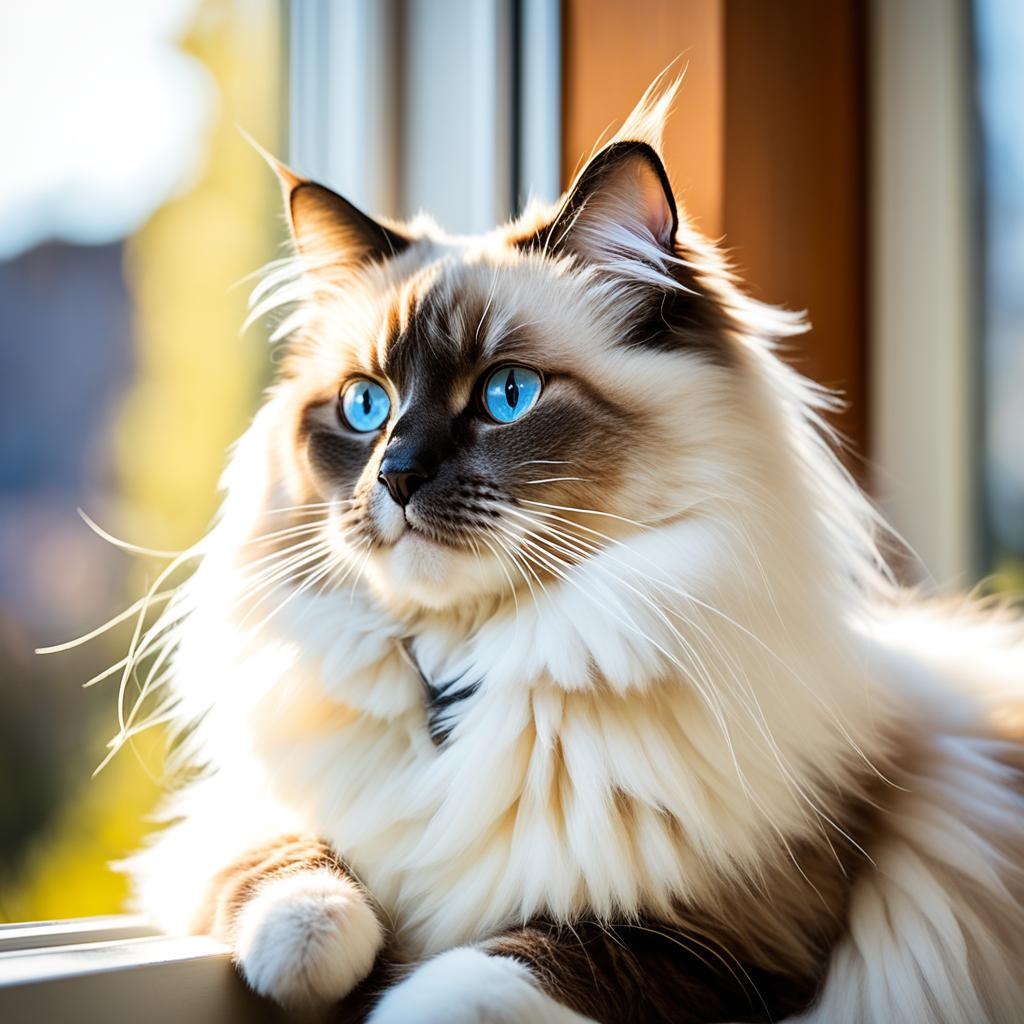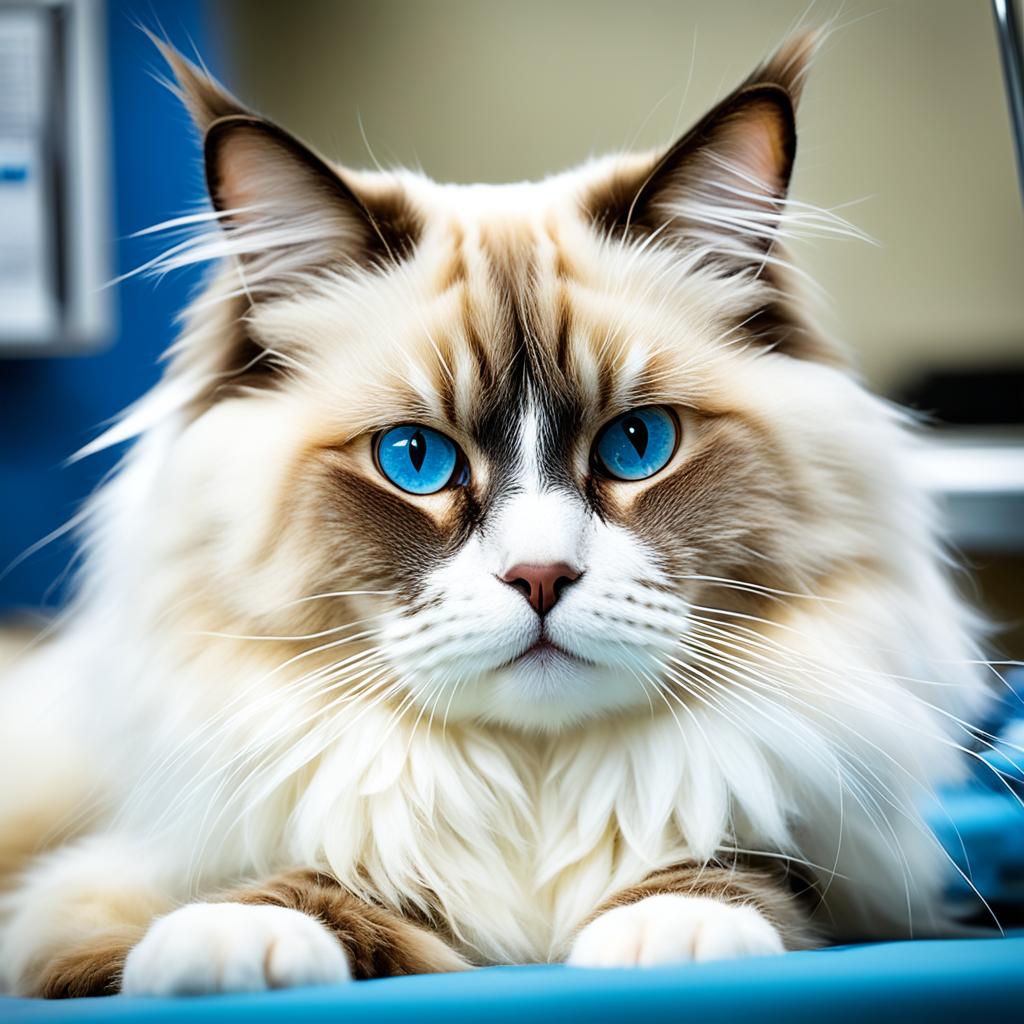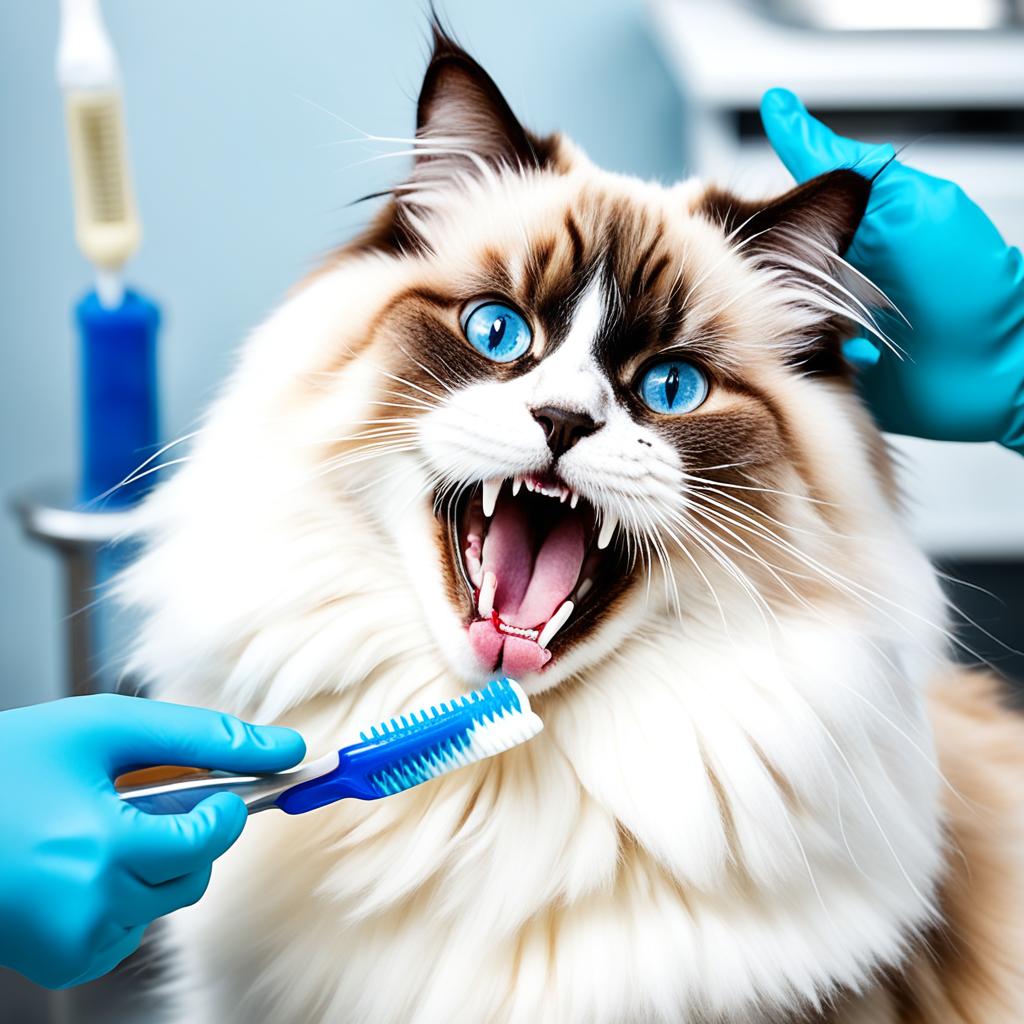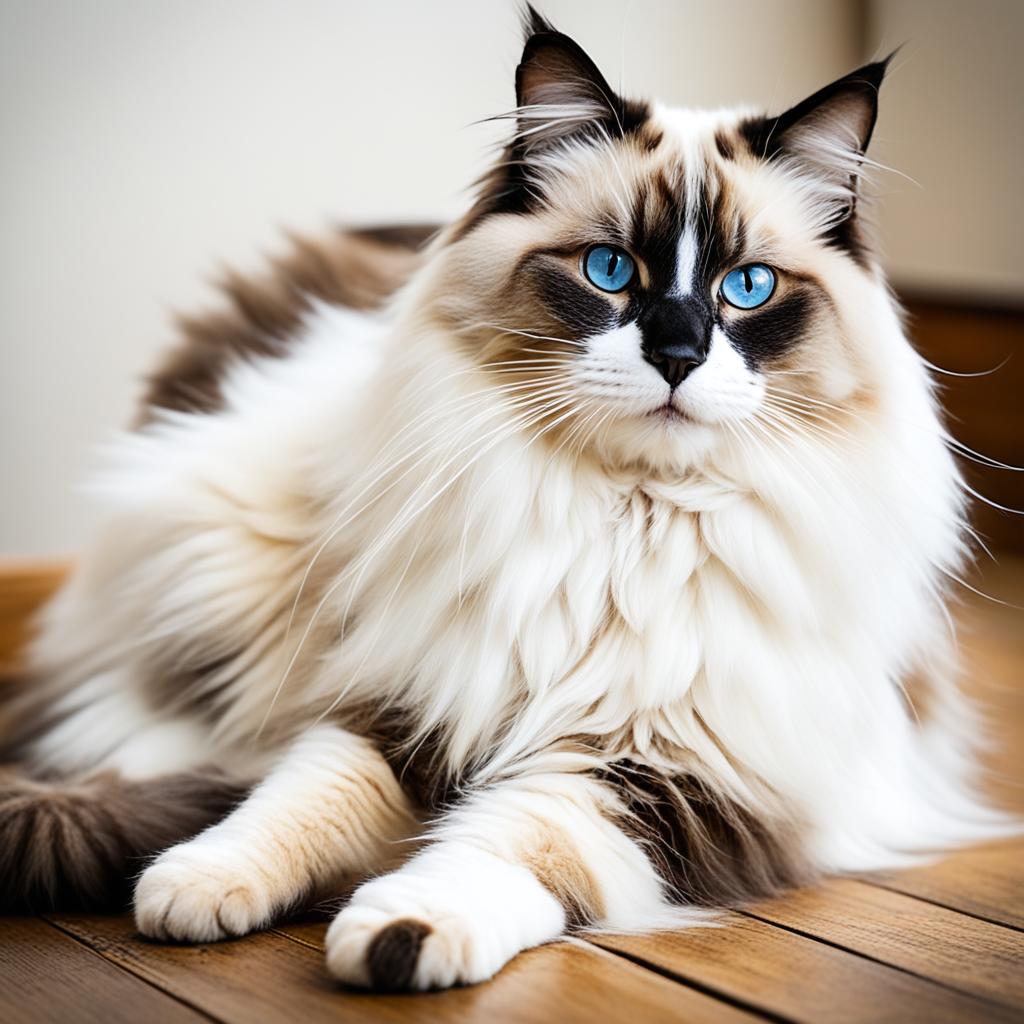Ever noticed your Ragdoll cat might face certain health issues more than other breeds? These cats have earned a global fan base for their tranquil demeanor and bright blue eyes. Beyond their sweet and loving behavior, they have some health risks to watch out for. Ragdolls are large, strong, and very calm by nature.
They truly light up the lives of their families. But to keep your Ragdoll healthy, it’s key to know the health problems they could face. This guide will cover what to look out for and how to keep your cat in top shape.
Now, we’ll look into the health problems that Ragdolls often face. Understanding these common issues will help you keep your cat healthy.
Key Takeaways
- Ragdoll cats have specific health considerations due to their unique physical attributes.
- Knowing about typical health problems in Ragdolls can ensure your cat lives a long, healthy life.
- Regular check-ups and good care are important for Ragdolls’ well-being.
- Hypertrophic Cardiomyopathy (HCM) is a common heart issue in Ragdoll cats.
- Watching their diet and making sure they get enough exercise helps prevent obesity and related issues.
Understanding the Unique Behaviors of Ragdoll Cats

Ragdoll cats stand out because of their distinct behaviors. One of these behaviors is going limp when they are held. This trait gives them their name, the “Ragdoll.”
Why Ragdolls Go Limp
When you hold a Ragdoll cat, it may go completely limp. This isn’t just a cute thing they do. It shows that they trust you deeply and feel relaxed.
Although this is a sign of trust, make sure your cat is healthy. Look out for any worrying signs to prevent health issues.
The Myth of Universal Blue Eyes
Many people think all Ragdoll cats must have blue eyes. Yet, this is not true. Ragdolls can also have green or gold eyes. Their eye color diversity is just one way they are unique.
This range of eye colors shows their diverse nature. It does not indicate any health problems. Instead, it celebrates the variety within the breed.
Learning about these behaviors helps you connect better with your Ragdoll. It also lets you spot the difference between their normal actions and any health concerns they may have. This knowledge helps ensure your cat is happy and healthy.
What Are Common Health Issues in Ragdoll Cats?

Owning a Ragdoll cat means dealing with potential health issues. Understanding their health concerns is key to caring for your cat well. We will look at some main health problems Ragdoll cats face.
Hypertrophic Cardiomyopathy (HCM)
HCM is a common heart condition in Ragdolls. It causes the heart muscles to thicken, leading to serious health problems. Signs of HCM are tiredness, trouble breathing, and sudden heart issues. Getting a diagnosis early and regular vet check-ups are essential.
Urinary Tract Problems
Ragdolls often have issues with their urinary tracts. This can include infections and blockages. Watch out for signs such as peeing a lot, straining, and bloody urine. Quick vet care and keeping your cat hydrated can prevent serious problems.
| Urinary Symptom | Possible Cause | Action Required |
|---|---|---|
| Frequent Urination | Urinary Tract Infection | Vet Visit |
| Straining | Bladder Stones | Immediate Care |
| Blood in Urine | UTI or Stones | Emergency Vet |
Obesity Concerns
Ragdolls can easily become overweight. This leads to other health problems like diabetes and joint pain. A good diet and playtime can help your cat stay healthy. Always check your cat’s weight and talk to a vet about the best care routine.
Hypertrophic Cardiomyopathy in Ragdolls

Hypertrophic Cardiomyopathy, or HCM, affects the hearts of Ragdoll cats. Catching it early can greatly help in their care. Regular check-ups should be a priority.
Signs and Symptoms of HCM
It’s important to watch for signs of Ragdoll cat HCM symptoms. These may include tiredness, breathing problems, not wanting to eat, and odd heart sounds.
Seeing these symptoms quickly may improve your cat’s life. Early detection is key.
Preventative Measures and Treatment
Preventing HCM’s effects is crucial for Ragdolls. Regular visits to the vet are a must. Vets can suggest medication to help.
- Get your cat’s heart checked often.
- Feed them well to keep their heart healthy.
- Let your cat move, but not too hard.
By following these steps, you can help your Ragdoll stay healthy. It also lowers the chances of HCM.
| Symptom | Preventative Measure |
|---|---|
| Lethargy | Regular veterinary check-ups |
| Rapid breathing | Cardiac screenings |
| Loss of appetite | Balanced diet |
| Heart murmurs | Follow treatment plans |
Urinary Tract Issues: Prevention and Treatment

Keeping Ragdoll cat urinary health in top shape ensures your cat stays happy and healthy. Watching for early signs is key, like if they pee more often, have blood in their urine, or struggle to pee.
Choosing the right foods is crucial for their bladder health. Go for meals that are rich in for moisture. It’s just as important to keep them drinking too. Adding wet foods or using a cat water fountain can help.
When looking at urinary tract problem treatment in Ragdolls, balance is key. Here are some important things to keep in mind:
- Stay away from foods high in magnesium to prevent urinary crystals.
- Don’t skip regular vet visits to catch issues early.
- Work with your vet on a diet plan that fits your cat’s needs.
Prevention is a big part of dealing with urinary problems. Quick action, like using antibiotics or changing their diet, can help a lot. Following these steps and working closely with your vet can keep your cat’s urinary health in check.
| Treatment Option | Benefits |
|---|---|
| Antibiotics | Effective against bacterial infections, providing quick relief. |
| Specialized Diets | Helps dissolve urinary crystals and supports urinary health. |
| Increased Hydration | Promotes dilute urine which helps prevent crystal formation. |
Be proactive in managing urinary issues in your Ragdoll. This will ensure a long, happy, and healthy life for your pet.
Obesity and Weight Management in Ragdoll Cats

It’s vital to watch your Ragdoll cat’s weight to avoid obesity. This issue can cause serious health problems for them. A good diet, exercise, and advice from professionals can keep your cat healthy.
Importance of a Balanced Diet
A balanced diet for Ragdolls is crucial. It’s tempting to give them extra food, but it can be harmful. Ensure you measure their food and choose high-quality, rich cat food. This approach will help control their weight and prevent them from gaining too much.
Role of Regular Exercise
Ragdolls are often calm, but they still need exercise. Play and regular activity are key. Use interactive toys or play fetch with them. This not only keeps them happy but also helps in preventing obesity.
Veterinary Guidance on Weight Management
It’s important to talk to your vet about your cat’s specific diet and exercise needs. Vets can offer personalized tips. They make sure your cat is healthy and avoids problems linked to obesity.
Genetic Disorders in Ragdoll Cats

Ragdoll cats are beautiful with their soft fur and big eyes. But they have Ragdoll cat genetic health conditions that need attention. Knowing about these issues and finding them early is key. This way, your cat can have a long, healthy life.
Common Genetic Conditions
Hypertrophic Cardiomyopathy (HCM) is common in Ragdolls. But there are other Ragdoll cat genetic health conditions to look out for:
- Polycystic Kidney Disease (PKD): It causes cysts in the kidneys and can lead to kidney failure.
- Feline Infectious Peritonitis (FIP): This virus affects the organs in the belly and can be deadly.
- Mucopolysaccharidosis (MPS): It messes with the body’s metabolism, causing issues with bones and joints.
Screening and Early Detection
Genetic screening for Ragdolls is a big step forward. Finding issues early means you can take action sooner. Here’s what you can do:
- Regular Veterinary Check-Ups: Regular visits to the vet can spot issues early.
- Genetic Testing: These tests can find possible health conditions your cat might have.
- Breeder Transparency: Choose breeders who share health clearances and the genetic history of their cats.
Being alert and taking steps can lead to a better life for your cat. It’s all about staying informed and acting early.
Dental Problems in Ragdoll Cats

It’s important to take care of your Ragdoll cat’s teeth. Dental health isn’t just about the mouth. It affects their whole body. We’ll talk about common dental problems and how to prevent them.
Common Dental Diseases
Ragdoll cats can face several dental issues. Let’s look at the most common ones:
- Gingivitis—Gums become inflamed from plaque.
- Periodontitis—This severe gum infection can damage gums and the jawbone.
- Tooth Resorption—The body starts breaking down the tooth structures.
- Stomatitis—It’s a painful mouth inflammation.
Preventative Dental Care Tips
Protecting your Ragdoll cat’s teeth is key. Here are ways to keep them clean and healthy:
- Regular Teeth Brushing—Brush your cat’s teeth with cat-safe toothpaste a few times each week.
- Provide Dental Chews—Chews can reduce plaque and tartar.
- Professional Vet Cleanings—Visit your vet for check-ups and cleanings regularly.
- Healthy Diet—Feed a diet that encourages good dental health.
Here’s a summary of dental problems and how to deal with them:
| Disease | Symptoms | Prevention |
|---|---|---|
| Gingivitis | Red, swollen gums | Brushing teeth often |
| Periodontitis | Loose teeth, bad breath | Get cleanings from the vet |
| Tooth Resorption | Missing teeth | Regular vet visits |
| Stomatitis | Painful ulcers | Eat healthy, see the vet |
Focus on these tips for your Ragdoll cat’s dental care. Doing so will prevent many common dental problems. It will also keep your cat happy and healthy.
Skin and Coat Conditions in Ragdolls

Ragdolls have beautiful, soft coats that make them lovely to look at and touch. But sometimes, their skin and coat might have health problems not visible at first. It’s important to know about and take care of these issues. This is key to keep them looking majestic and feeling good.
Common Skin Conditions
Ragdolls are more likely to have certain skin problems. Things like dandruff, fungal infections, and flea allergies can bother them. It’s a good idea to check your Ragdoll’s coat often to catch these issues early. Look out for bald spots or if they are scratching a lot. If you see these, a vet visit is needed.
Preventative Care for Skin Health
Keeping ahead of problems is very important. Grooming your Ragdoll regularly is crucial for their skin. It keeps their fur looking great and helps spot issues early. A diet full of omega-3s is also good for their coat and skin. Plus, making sure they drink enough water can help prevent many skin problems.
| Condition | Symptoms | Preventative Measures |
|---|---|---|
| Dandruff | Flaky skin on fur | Regular grooming, omega-3 rich diet |
| Fungal Infections | Red, itchy patches | Keep coat dry, routine vet checks |
| Flea Allergies | Excessive scratching, red bumps | Flea treatments, clean living areas |
Being watchful and giving your Ragdoll great care will ensure their coat and personality shine.
Ensuring Proper Veterinary Care
If you own a Ragdoll cat, you know they can face big health problems. It’s not enough to react to illnesses. You must also create a proactive healthcare plan. Checking your cat’s health regularly helps catch any problems early and keeps them healthy.
Vaccines are very important for your Ragdoll’s health. They protect against many diseases, keeping both your cat and others safe. Your vet can create a custom vaccination plan for your Ragdoll, based on their lifestyle and health needs.
Early signs of illness are key to your Ragdoll’s well-being. Watch for any changes in behavior, eating, weight, or strange symptoms. Catching problems early can stop them from getting worse. Taking action quickly will save you and your cat a lot of trouble.
Regular vet visits, up-to-date vaccines, and watching for behavior changes are crucial. These steps will keep your Ragdoll cat healthy and happy. By following this advice, you can ensure your furry friend lives a long and joyful life.




